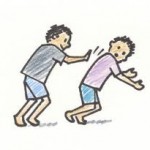 Over the past few weeks it has been impossible to miss the flood of news stories about gay teens ending their own lives after enduring anti-gay bullying. Eighteen-year-old Tyler Clementi, 15-year-old Billy Lucas, and 13-year-olds Asher Brown and Seth Walsh were living in different corners of America — New Jersey, Indiana, Texas, and California — but each of them was subjected to the same kind of intolerance and cruelty, which included callous disregard for their online privacy.
Over the past few weeks it has been impossible to miss the flood of news stories about gay teens ending their own lives after enduring anti-gay bullying. Eighteen-year-old Tyler Clementi, 15-year-old Billy Lucas, and 13-year-olds Asher Brown and Seth Walsh were living in different corners of America — New Jersey, Indiana, Texas, and California — but each of them was subjected to the same kind of intolerance and cruelty, which included callous disregard for their online privacy.
To put this tragedy in context, suicide is the third leading cause of death among adolescents aged 15 to 24, and gay teens are six times more likely than straight teens to attempt suicide. It’s important to understand, though, that the statistics concerning gay teens are relevant to all teens. There are many reasons for this, but chief among them is that during adolescence, the mantra is, “I want to be the same, I want to be the same, I want to be the same.” Teens want to be like everyone else, and when they see a gay student getting bullied for some perceived difference, they worry that their own differences — and we all have them — will be targeted by bullies next.
I know that many parents find it difficult to discuss sexuality with their teens, but discussion is crucial if we want our teens to develop good self-esteem, embrace their own differences, and accept what is different in others.
Here’s some information for parents to consider:
Teens who are “different” are at higher risk for getting bullied.
All teens want to be “normal” and fit in with their peers, but when they exhibit differences — in their sexual orientation, for example — they can face cruel and unusual harassment and rejection. According to a survey by the Gay, Lesbian, and Straight Education Network, approximately 90 percent of gay, lesbian, transgender or bisexual middle and high school students were physically or verbally harassed in 2009. As parents, no matter what we believe (with respect to sexuality, religion, politics, etc.), we are responsible for our kids’ behavior and need to teach them to be intolerant of intolerance.
A teen who believes his sexual feelings are unacceptable to peers may be experiencing emotions that are warning signs of suicide.
Parents, teachers, and all caring adults need to be alert and sensitive to how self-esteem contributes to a teen’s feelings of sadness, worthlessness, hopelessness, anxiety, irritability, rejection, and anger — all symptoms of depression that affect the majority of teens who attempt or complete suicide. Some parents fall under the impression that because they are tolerant of different sexual orientations, their children aren’t affected by the barrage of messages about “how wrong it is to be gay.” Unfortunately, anti-gay rhetoric has extraordinary, insidious muscle in the cultural landscape, and gay teens are particularly vulnerable to the discrimination and bullying that chip away at self-esteem and contribute to depression. Parents of gay teens are sometimes just “the last to know” a problem is brewing.
An overwhelming majority of suicidal teens report feeling misunderstood by their parents.
Therefore, it’s crucial for parents to start a conversation with their children, before they go through puberty, to discuss sexual feelings and tolerance of different sexual orientations. If your child is secretly feeling guilty or somehow bad due to the sexual thoughts he or she is having, you need to know this so that you can give reassurance that there’s nothing wrong or bad about different sexual thoughts or sexuality in general. Teens who feel uncomfortable with their sexuality often suffer from low self-esteem, so it’s essential that we counter their feelings of distress with a very positive message of acceptance and love. We have a responsibility and role in building our teens’ self-esteem and self-confidence. They need to understand that while we sometimes disagree with them — or simply have different feelings — we respect their beliefs and differences. We love them no matter what.
As part of the effort to prevent suicide and suicidal behaviors, parents need to know about their teens’ lives on the Internet.
I’m reminded of a scene in the new Facebook movie, “The Social Network,” in which Napster co-founder Sean Parker (played by Justin Timberlake) says, “We lived on farms. We lived in cities. And now we live on the Internet.” That we now “live” on the Internet means that, as parents and educators, we must be whistleblowers on Facebook, Twitter, and any other social media platform on which our kids interact — to tackle intolerance and bullying effectively. Online bullying often involves the complete failure, on the part of a bully, to comprehend how words and actions in cyberspace can devastate a victim. Erica makes this point in “The Social Network” when she tells Mark Zuckerberg that saying something cruel to a person’s face is like using a pencil (since spoken words can fade from memory), but saying something online, where words are recorded for an unknown number of people to see, is like using a pen. We have to talk to our kids about the power and consequences of our online behavior. And then we need to teach them how to use social media as a tool for promoting tolerance, compassion, and social justice.
Parent-teen communication is our best defense against intolerance, bullying, and teen suicide.
Believe it or not, teens want to spend time with their parents. We sometimes forget this as we watch them try to assert their independence, but research studies repeatedly show that teens want to spend quality time with us — and when they do, they’re less likely to experiment with drugs, have sex at a young age, and engage in other risky behaviors. We have the opportunity to build our kids’ confidence and self-esteem, nurture empathy, and model an acceptance and appreciation of others. However (and this is key), teens only want to spend time with their parents — and talk openly about what they’re really experiencing — when they believe their parents aren’t judgmental. Again, tolerance, respect, appreciation, love.
I’m encouraged by the fact that so many celebrities — from Cyndi Lauper and Ellen DeGeneres to Matthew Morrison, Jane Lynch, and the entire cast of “Glee” — are raising public awareness of anti-gay bullying and its links to teen suicide.
I hope you will join me in promoting tolerance to protect young lives. Please start right now by having a conversation with your child.
Harold S. Koplewicz, M.D. is a leading child and adolescent psychiatrist and the president of the Child Mind Institute.
 (TRENTON, N.J.) — Lawmakers in New Jersey will hold hearings Monday on a bill to toughen the state’s anti-bullying laws.
(TRENTON, N.J.) — Lawmakers in New Jersey will hold hearings Monday on a bill to toughen the state’s anti-bullying laws.




 Acceptance as Core Curriculum
Acceptance as Core Curriculum  Make It Comprehensive
Make It Comprehensive










